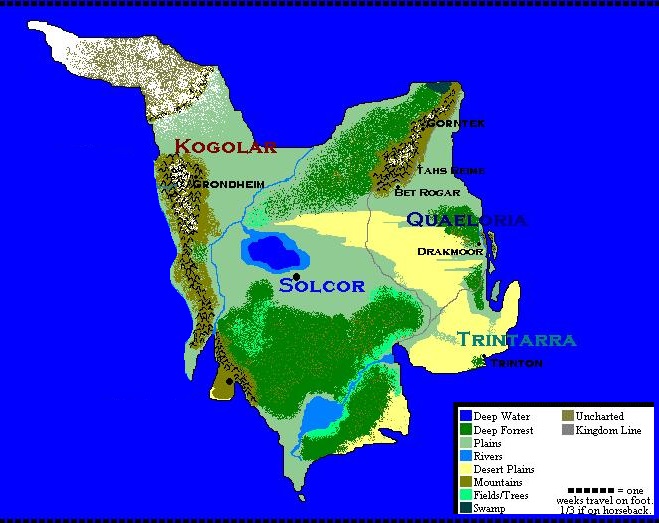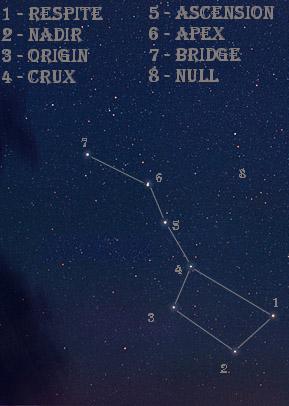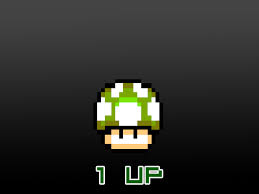|
World Of CRUX
|
Character Creation
|
|
Character Update
|
Play Online!
|
The World
| The Story | The Continents | The NULL | Cycles | Imperial Calendar | The Magics |

In Medias Res
While you may just be starting out on your adventure, the setting and history that exists in our story have been building for ages.The Human King, of the continent of Imperium, spent years at war with the other races of His land before their submission to his rule. Years of warring eventually gave way to political pursuits which finally resulted in a civil resolution. After years of bloodshed and loss, the current rulers of the other Races of Imperium, the Dwarves, Striders and Quicken, surrendered to the Human King's rule, conceding that defeat was merely a matter of time which would only result in further losses. Now that the war had been settled, trade among the Races slowly began to resume. Eventually, after a few progressive trade agreements, the King saw the need for a more universal form of trade. So, he decided to create coins of a specific weight and cast to use as currency. This was well received by the other Races, especially the Dwarves, whose smithing expertise he had to employ to have them fashioned. For about 16 years, this newfound peace and commerce was enjoyed and just as the Races were settling in to their respective roles under the newly formed Empire, the Gates began appearing....
The first gate appeared in the northeast near the foothills of the Gorntek Mountain range. These lands were populated by the Striders, who had previously been the least involved in the war as they tried their best to be a peaceful race. Before any real investigation into the gate itself could be attempted, hundreds of creatures began pouring out of it and attacking anything and everything. It was the Human King who came to the aid of the Striders and helped to drive back the invading force before the local lands were overrun with these spawn. This earned the King much favor among the other Races for coming to their aid and enforced his role as the sole ruler and protective force for the lands. His leadership and strategy, which he had previously enlisted to win the war, were now put to use against his new albatross, the defense of the realm.
Over the next decade, the King built a series of outposts and garrisons across the entire continent. He established engagement protocols for any instances of a gate. At first, no outside entities were allowed to pass through the gates, regardless of their apparent intent. A few years and many skirmishes later, some of the more civilized Races from other continents began sending emmisaries through the gates. Some merely wanted to be able to explore, others hoped to engage in commerce. It became evident that some of the lands where these various gates originated had vastly different agriculture and resources, including different weapons and various magics. While it was easy enough to force visitors to disarm themselves, it was impossible to stop them from using their magics. This resulted in the drafting and enforcement of the Imperium Laws of Casting (I-LOC). There are many stories which accompany the progress since the first enacting of the Laws, but it would suffice to say that the punishments and enforcement have relaxed a bit over the years. Another set of laws, which existed long before the gates began appearing, are the Honors and Reverence customs for Nobility and Rank. These laws are very much in force across Imperium and required of visitors and natives alike.
Crux
CRUX is a world populated by dozens if not hundreds of continents, commonly called islands. Each island has it's own society made up of varying races and cultures. No two islands or races are the same. At first glance, it would appear that two races from the same island might have some commonalities between them. This isn't so in all cases though. Some islands have as many as five or six different races on them and seem to have nothing in common among them. The races may be at peace or at war, living in simbiotic harmony or in a state of constant strife, fighting for survival. The arrival of the Gates, however, is beginning to change all of that. There is little known about the Gates' origins or even their real use or function. Usually there may only be one or two of these portal-like Gates on any given island. What's more is races have found there are restrictions on which Gates they can pass through and some are only able to travel through Gates which originate on their island. Some have even reported using the same portal to arrive at different locations. As far as anyone knows, the only way to travel among the different islands has been via the portals which seem to appear at random and without cause. The one island which seems to be developing portals at a rapid rate is the Island of Imperium.The Null
Known by creatures as various things and sometimes referred to as Death’s Gate, the Plane of Death or the Negative Plane.The Null is a very peculiar place. Once you think you understand how it exists or what you may be seeing in that place or plane, it changes or appears to become what you do not expect. The fastest way to enter the Null is to die. Your spirit travels through the Null in order to return to the world of the living. It is believed that when you die permanently, you spirit remains stuck in the Null. There are seven Aspects of the Null; The Mother, The Father, The Child, The Horror, The Inquisitor, The Conspirator, and the Embodiment. Our experience and perception of their personas are captured here as have been told by those who have witnessed them.
The Mother – Nurturing and sympathetic. She is always happy to have visitors to her realm and very judgmental of inappropriate behavior.
The Father – Old and set in his ways. He is not very concerned with others’ purpose. He often has an “I told you so,” or “I could’ve told you that was a bad idea” type of attitude. He has been around for ages and has seen it all so not many people surprise him.
The Child – Playful and curious. He/She doesn’t really want to be here in the Null and would love to find out more about the world on the “outside.” Likely to ask questions about people’s powers and whether they have seen a real horse before.
The Horror – Preys on your fears and doubts. He is a beast of consumption and will do his best to convince you that you are not long for this world.
The Inquisitor – Analyzes your answers and poses riddles. He is likely to ask you what you think and force you to consider things you may or may not care about. “Why are you here?”
The Conspiritor – Looking to gain control of the Null and overtake the other six Aspects. He appears as a friend, but only to gain knowledge of the other Aspects and the outside world. He has no real use for those who are visiting the Null for the first time as they probably have no useful information for him, but he may be inclined to ask you to do him a favor in return for something.
The Embodiment – A spirit essence and protector. This creature seeks to keep the balance and maintain the Null as it presently exists. Obviously this is the opposite of the Conspirator, but it too may offer favors in return for tasks. Also asks what the other Aspects are up to so it may be difficult to decipher whether you are talking to the Embodiment or the Conspirator at times.
Cycles of the Null
The Null and its Aspects are cyclical in their effects and phenomena. The pattern is said to relate to the familiar star pattern in the sky which resembles a ladle.
The cycles and their assumed relationships to the elements are as follows:
| ORDER | CYCLE | NAME | ELEMENT |
| ONE | 48 Days | Respite | Water |
| TWO | 48 Days | Nadir | Light |
| THREE | 48 Days | Origin | Earth |
| FOUR | 48 Days | Crux | Life |
| FIVE | 48 Days | Ascension | Air |
| SIX | 48 Days | Apex | Darkness |
| SEVEN | 48 Days | Bridge | Fire |
| EIGHT | 29-30 Days | Null | Death |
The completion of all eight cycles is called a Milestone.
Often a person's age is tracked in Milestones or "Stones" and a person with little experience is said to have "no stones."
The calendar cycles of Milestones are also in groups of eight. So, eight milestones are called a Scale and eight Scales are a Lifetime. This means a Lifetime is 64 Milestones.
There are even appellations used to track the passing of Lifetimes. Eight Lifetimes are a Period and eight Periods are an Age.
The entire record of a day in a Cycle is listed as the Day, Cycle, Lifetime, Scale and Milestone. For example, "12th of Origin, 2~43" would denote the 12 day of the Third Cycle(Origin) of the second Milestone of the 4th Scale in 3 Lifetimes. This is also the same as the 108th day of Milestone 226. More recently, the aggregate Milestone is simply used, such as 2117. Many Races record their dates in various ways, but most all of them are characterized by the cycles of the Null. A new Milestone begins on the 1st of Respite. The last day of a Milestone would be the last day of the eighth cycle of the Null, 29th or 30th of Null. Every half-scale, or 4 Milestones, the Null appears to last an extra day. The reason for this is unknown.
Some scholars would argue whether there are zeros in this cycle and others say that the Null or 8's are the zeros. Either way, this is how dates have been decidedly recorded for over 30 Lifetimes now.
Today's Milestone is 2117, which is recorded as the 5~883 or the 5th Milestone, of the 8th Scale in 8 Lifetimes and 3 Periods.
While that may sound complicated, think about our real life calendar year, 2017.
It isn't written out as the 7th Year of the 2nd Decade of the 1st Century in 2 Milenia, but that is essentially what it means.
Here's a calculator to help you figure it all out!


